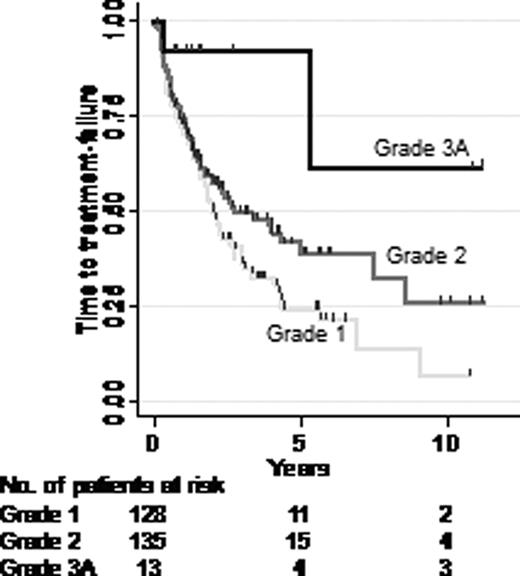Abstract
Abstract 1641
The World Health Organization (WHO) classification allocates indolent follicular lymphoma to grades 1, 2 or 3A according to the proportions of small centrocytes and large centroblasts in the neoplastic follicles. The prognostic value of the WHO's grading system in indolent follicular lymphoma has not been investigated in patients given the anti-CD20 monoclonal antibody rituximab without chemotherapy.
We prospectively reviewed the follicular lymphoma grades in 276 grade 1–3A patients who received upfront rituximab without chemotherapy in two randomized trials. Flow cytometry analyses of malignant and nonmalignant lymphocyte subsets in lymph nodes and blood were also assessed.
In these patients given upfront rituximab-containing therapy, increasing grades of 1, 2, and 3A correlated with longer time to treatment-failure (P =0.002) and overall survival (P =0.045), independently of clinical factors (including the follicular lymphoma international prognostic index). The grades' impact was also independent of the levels of CD3+, CD4+, and CD8+ T cells in lymph nodes and in blood.
Increasing grades of indolent follicular lymphoma correlate with better outcome in patients treated upfront with rituximab without chemotherapy, independently of clinical and immunologic factors. This suggests that treatment with rituximab acts differentially in tumors depending on the centrocyte/centroblast ratio.
Independent prognostic factors for time to treatment-failure
| Category . | Time to treatment-failure . | ||
|---|---|---|---|
| HR . | 95% CI . | P . | |
| B symptoms | 1.7 | 1.2 to 2.4 | 0.005 |
| Elevated lactate dehydrogenase | 1.8 | 1.2 to 2.8 | 0.0003 |
| World Health Organization grades | 0.002 | ||
| Grade 1 | 1 | ||
| Grade 2 | 0.71 | 0.51 to 0.99 | |
| Grade 3A | 0.18 | 0.05 to 0.76 | |
| Category . | Time to treatment-failure . | ||
|---|---|---|---|
| HR . | 95% CI . | P . | |
| B symptoms | 1.7 | 1.2 to 2.4 | 0.005 |
| Elevated lactate dehydrogenase | 1.8 | 1.2 to 2.8 | 0.0003 |
| World Health Organization grades | 0.002 | ||
| Grade 1 | 1 | ||
| Grade 2 | 0.71 | 0.51 to 0.99 | |
| Grade 3A | 0.18 | 0.05 to 0.76 | |
Abbreviations: HR, hazard ratio and CI, confidence interval. The number of observations was 276.
No relevant conflicts of interest to declare.
Author notes
Asterisk with author names denotes non-ASH members.


This feature is available to Subscribers Only
Sign In or Create an Account Close Modal